As an Amazon Associate I earn from qualifying purchases. Please read the disclaimer for more info.
What to Eat in Cambodia – Delicious Cambodian Food
When deciding on what to eat to Cambodia, it can appear that Cambodian food suffers in the wake of its more culinary famous neighbours, Vietnam and Thailand.
However, visitors to Cambodia need not worry as Khmer food is varied, with excellent quality, well priced, with enough flavour profiles to suit all palates.
In multiple visits to Cambodia, we have never been bored with the range of Cambodian foods.
In this introductory guide to Cambodian cuisine, I’ve teamed up with a few fellow travellers to outline some Cambodian food experiences you should try when visiting this country.
The Classic Cambodian Dishes
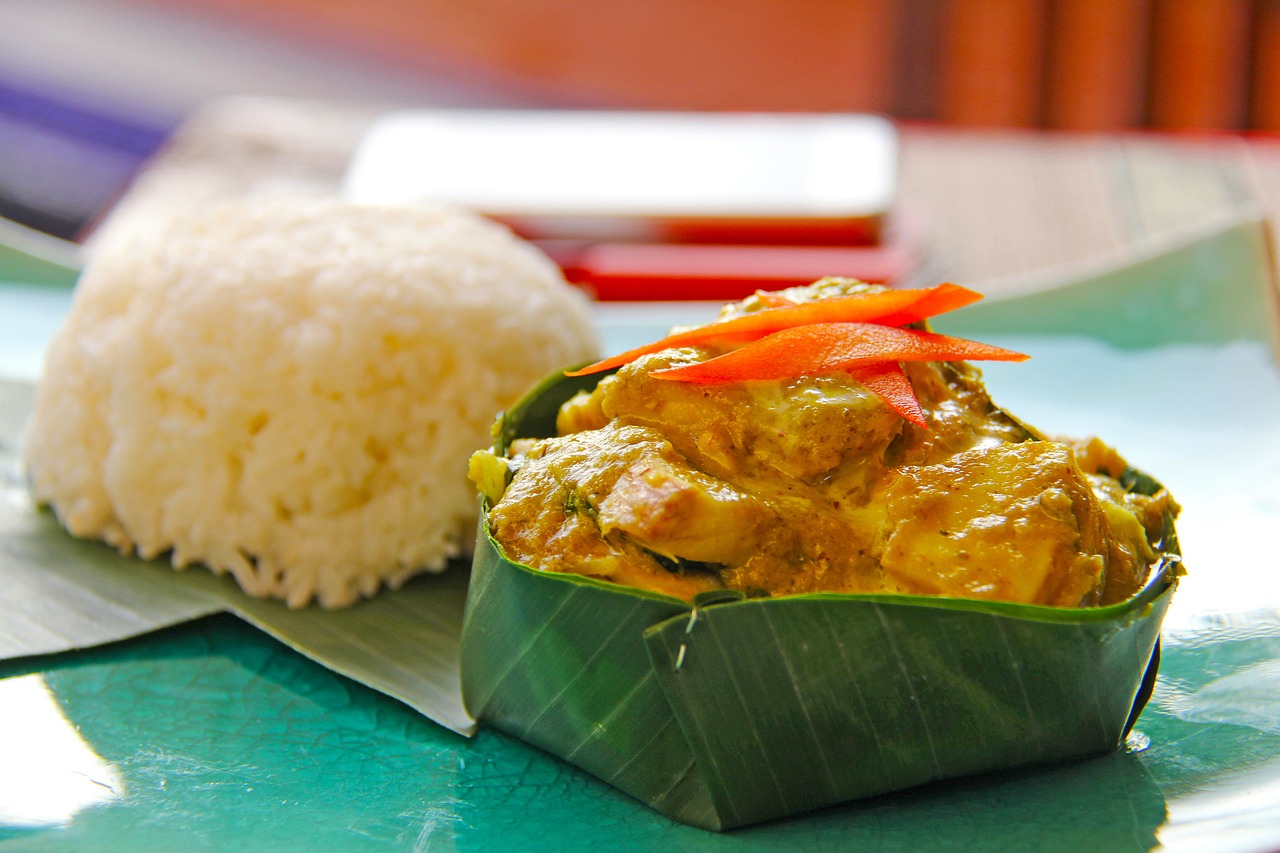
Steamed Fish Amok – how nice does that look?
There are a few very well-known traditional Cambodian dishes that visitors gravitate to when they think of what to eat in Cambodia. They are cheap, easy to find, and best of all, they are all extremely delicious.
Fish Amok
Jackie Szeto and Justin Huynh from Life of Doing discuss their experience with fish amok:
“The best Cambodian dish that comes to our mind is fish amok, an iconic dish of diced boneless freshwater fish simmered in a coconut curry sauce. Fresh spices in the curry paste include galangal, garlic, lemongrass, shallots, and chili, and mixed with coconut milk for the delicious sauce.
We’ve had fish amok prepared two ways. The first method is through steaming. The fish amok is placed in a homemade cup made out of a banana leaf and then steamed. We prefer this style as the fish stays moist and it’s a unique way to serve the meal. The other cooking method is stir-fried in a wok. It tends to be drier and more curry like with the amount of sauce. Sometimes the final dish is topped with a dollop of coconut cream for more richness. It’s also served with steamed rice.
Most Cambodian local shops and restaurants will have fish amok on the menu. We love how everyone has their own version of this dish so you can try all the variations as you travel through Cambodia.”
Khmer Red Curry
Soumya Gayatri from Stories By Soumya gives her thoughts on this iconic dish:
“Khmer red curry, also locally known as Samlor Kari, is made out of chicken, beef, or fish. Apart from protein, this Cambodian red curry includes a lot of other stuff such as green beans, potatoes, bamboo shoots, julienned onions, lemongrass, fresh coconut milk, and the traditional kroeung paste.
People often describe the Khmer red curry as a close cousin of the Thai red curry. But I don’t think so. Samlor Kari is thinner than the Thai one. It is more like a soup than a thick curry. And the best part is that it is much less spicy than its Thai counterpart. Plus, it is served along with bread (an effect of the French rule) though you can also ask for rice alongside.
Samlor Kari holds a special place in the Cambodian culture. It is cooked and eaten only on special occasions such as weddings, religious holidays, and during family gatherings. Perhaps, this is a reason why it is less popular than the Cambodian Amok even though it is equally delectable.
While traveling in Cambodia, you can find Khmer red curry in almost any restaurant in and around Angkor. However, I would highly recommend trying it at a local shack on your way to one of the more offbeat Khmer temples. That, in my opinion, will give you a taste of the real Khmer red curry.”
Lok Lak
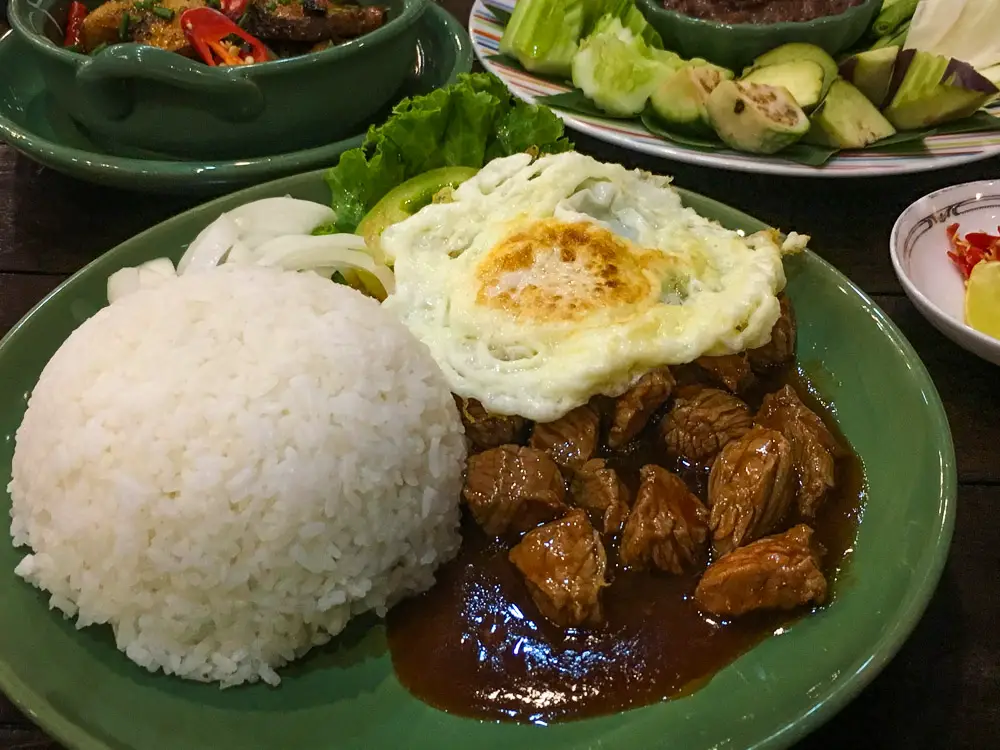
The beef in Cambodia was tender and tasty making beef lok lak an excellent dish.
One of the best Cambodian dishes that we enjoyed on more than one occasion during our time in Cambodia, is beef Lok Lak. This food from Cambodia is a beef stir fry dish served in a brown sauce, with fresh vegetables of onions, raw cucumber, tomatoes, and lettuce.
It is accompanied by rice, a tart dipping sauce of salt, pepper, and lime juice, and topped by a fried egg.
Beef Lok Lak is a staple Cambodian dish and found at many Khmer restaurants.
Crabs and Peppercorns – Kep and Kampot
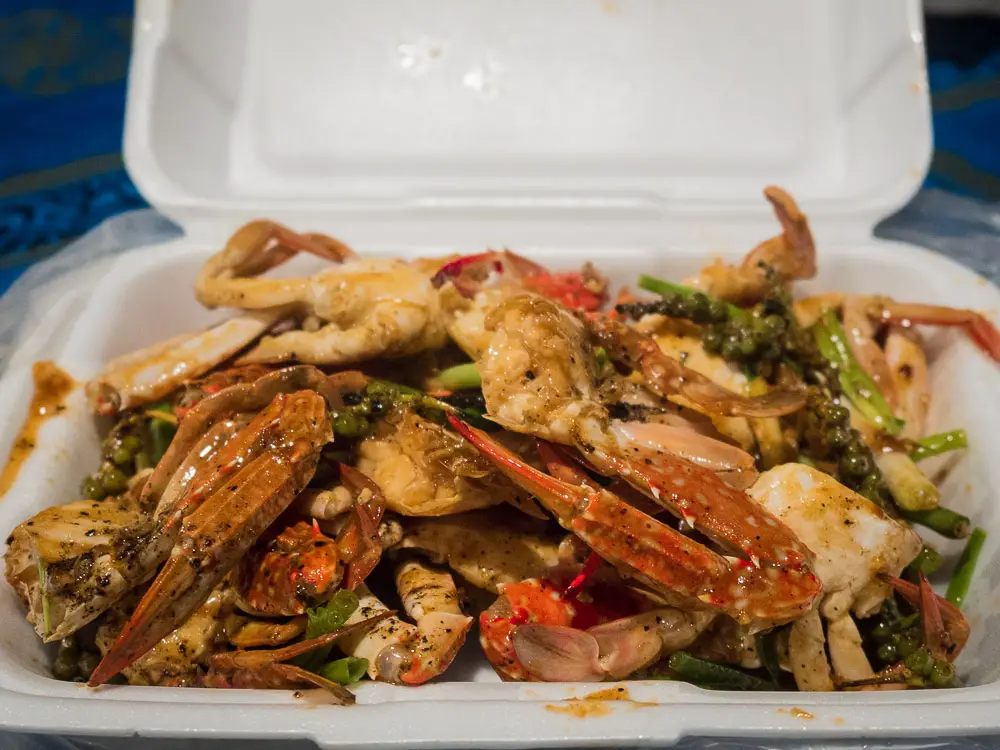
Southern Cambodia is home to two unique food hotspots, both of which happen to meld together very well. The towns of Kep and Kampot, a short tuk tuk ride away from each other, are home to the famous Kampot Pepper and the bustling Kep crab market.
The Kep crab market is one of the more interesting markets in Cambodia, with vendors keeping their “stock” alive in crab pots in the ocean just off the main market pier. When customers want to purchase crabs, the vendors retrieve the crab pots from the ocean, with the customer choosing which ones to buy from the live stock.
The market is set up to have the freshly purchased crabs cooked in a style of your liking and eaten, along with other cooked seafood, at communal tables.
The best way to eat the crabs, in our opinion anyway, is to combine the sweet meat with the bite of the local pepper, in the famous Kampot pepper crab dish.
Both the Kep crab market and Kampot pepper farms are open to the public, and a visit to both is highly recommended if your are in southern Cambodia.
What to Eat for Breakfast in Cambodia
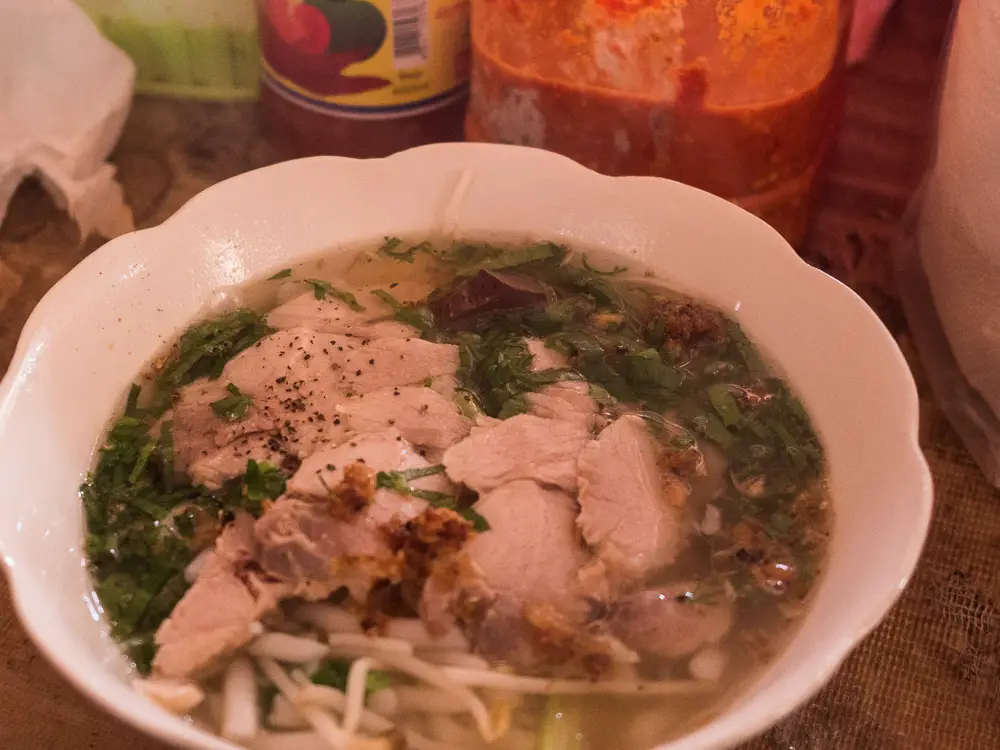
Noodles are a popular breakfast dish and this bowl of kyteow is topped with slices of pork.
Similar to Com Tam in Vietnam, Bai Sach Chrouk is a Cambodian breakfast dish of grilled marinated pork, broken rice, and pickled vegetables, sold by vendors that can be found everywhere on the streets of Cambodia, often selling out by mid- morning.
Another popular Cambodian breakfast dish to look out for is Bobor, which is a rice porridge similar to Congee in China and Chao in Vietnam.
Noodles are also prominent on the Cambodian breakfast menu with dishes such as Nom Banh Chok, which is rice noodles topped with a fish-based green curry, and Kuy Teav, a noodle soup with a broth made from pork and beef bones, and served with fried shallots, green onions, and bean sprouts. The soup is often topped with a combination of fish, pork, fish cake, or chicken depending on the the vendor has available.
The introduction of Num Pang, a baguette filled with a combination of meats, pâté, butter, mayonnaise, vegetables, and chilli, was, similar to Banh Mi in Vietnam, influenced by French colonisation of Cambodia.
And for those looking for breakfast on the go, Cambodian’s sometimes pick up a Nom Kong, a Cambodian street food.
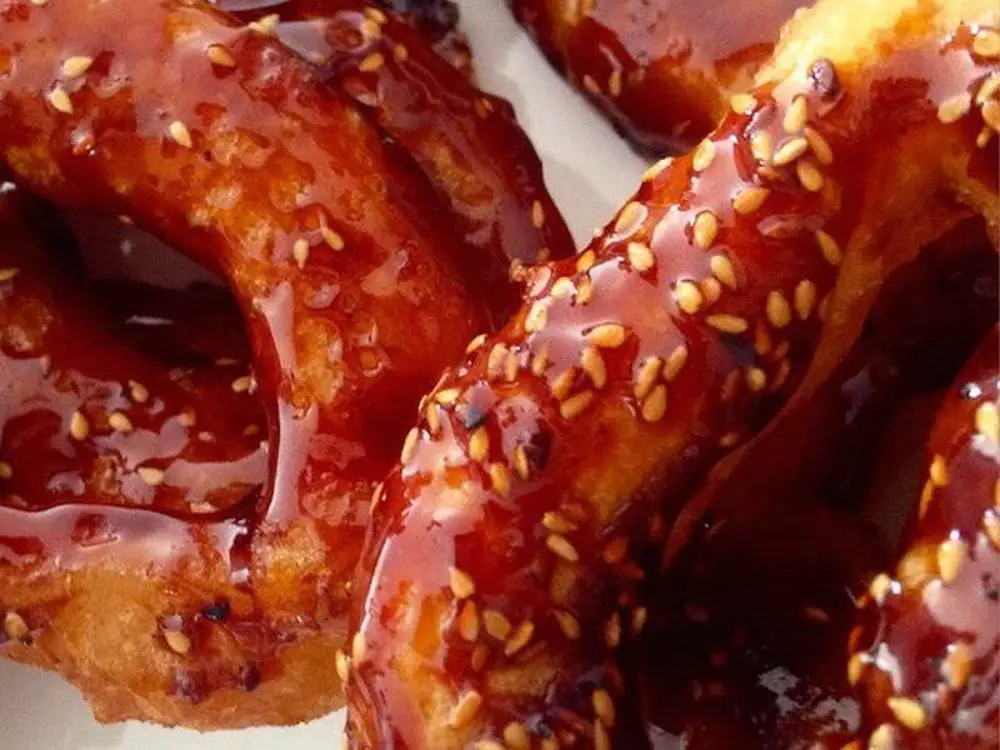
The sesame seed and sugar coated exterior of the Nom Kong.
Wendy Werneth from The Nomadic Vegan, gives us a detailed explanation of Nom Kong:
“Cambodia is a dream destination for anyone who loves street food, and especially sweet, fried street food. A prime example is nom kong, a type of rice cake similar to a doughnut. Like doughnuts, nom kong are made from dough that is shaped into a ring and fried. The main difference, though, is that the dough used to make nom kong is rice flour dough rather than wheat flour and is slightly chewy. Coconut milk is also added to the batter rather than cow’s milk, which means that nom kong are a naturally dairy-free and vegan Cambodian food.
Once the rings come out of the frying oil, they are topped with a hard, sugary glaze, and sesame seeds are sprinkled on top. The hard glaze cracks when you bite into it and makes an interesting contrast to the chewy doughnut underneath. Just be warned that it can be a bit hard on your teeth! You can find nom kong at street food stalls all over Cambodia.”
Eating at Markets
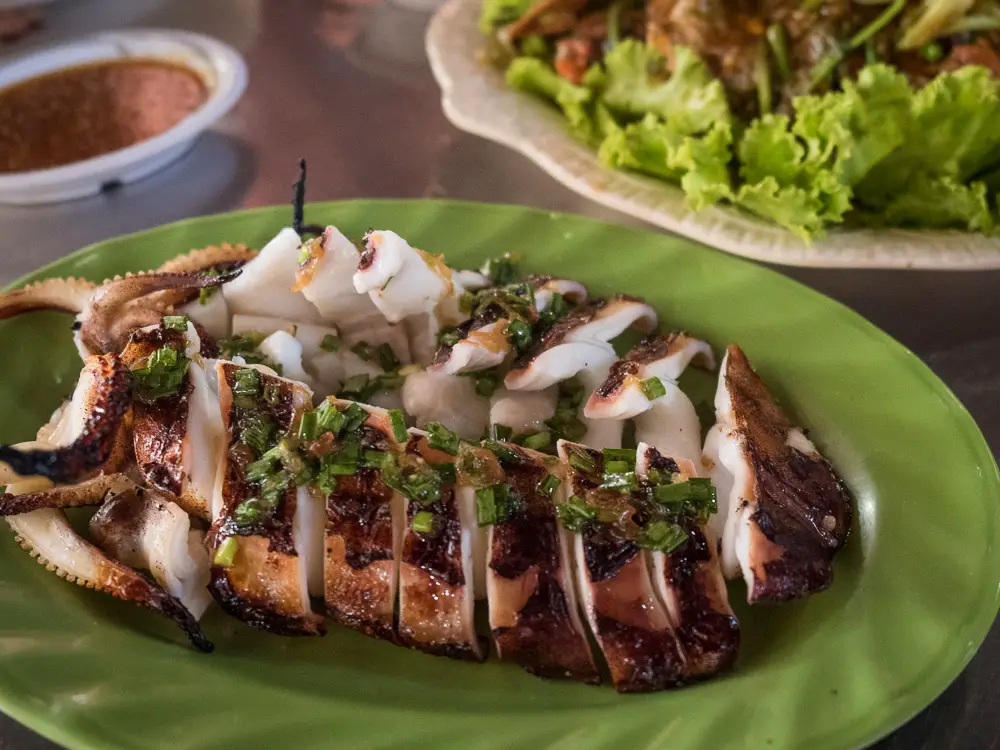
We chose one of the smaller squid (Ang Dtray-Meauk) that was available as we usually tried a few dishes for lunch.
One of our favourite ways of sampling Khmer cuisine was to frequent the food sections of local Cambodian markets throughout the country. They were always hot and humid affairs, but always a welcome respite from wandering the narrow aisles of the markets looking for that allusive bargain.
Breakfasts were always busy affairs (see above) with popular Cambodian dishes such as Nom Banh Chok and Kuy Teav always available, with other offerings including skewered offal, grilled dried fish, rice soup, fish cake covered vegetables, and spring rolls to name a few.
However, if there was one element of eating at markets that was a constant draw, it was the vendors grilling fresh and dried seafood over charcoal on large grills. And it didn’t seem to matter how small the available space was, the smoke always disappeared but the appetite inducing aroma remained.
The seafood options tended to be fairly consistent across Cambodia with prawns, baby octopus, dried fish, and some of the biggest Ang Dtray-Meauk (squid) we’ve seen, always available.
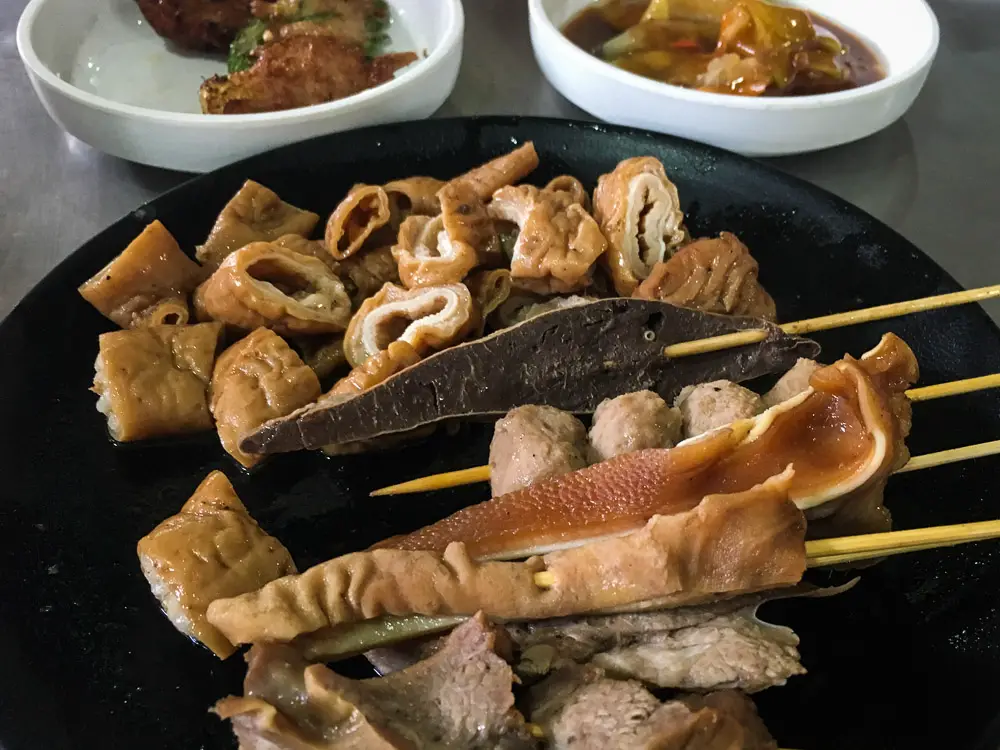
There is always a good variety of offal available at local Cambodian markets
Cambodian Street Food – the Weird and the Wonderful
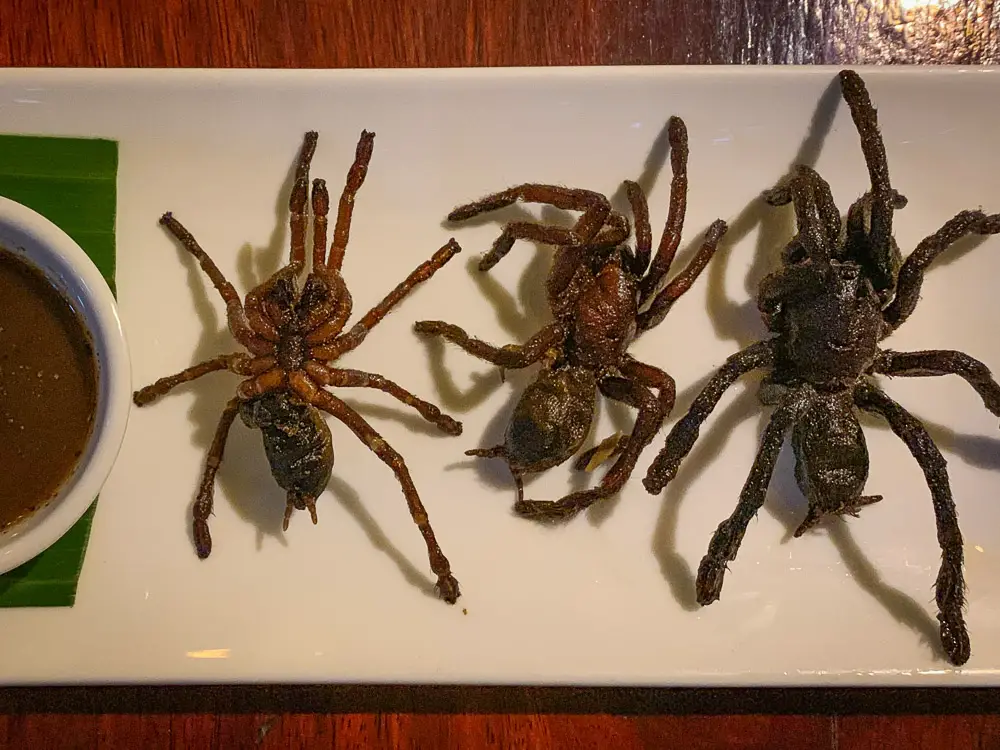
The taste of Tarantulas are similar to that of soft shell crab, with a slight crunchy and chewy texture.
For most visitors to Cambodia, the thought of snacking on spiders, rats, crickets, snails, frogs, and duck foetuses, may either seem quite an oddity, or raise the curiosity levels enough to try some.
Cambodian’s enjoy these snacks any time of the day, although some are more suited to enjoying with beer later in the day, especially at night, when carts of insects are wheeled out to busy streets.
Carine and Derek from We Did it Our Way, raise the interesting subject of reducing our carbon footprint by eating bugs.
“One of the first things we wanted to do when we arrived in Siem Reap was to try the bugs. We had heard it was possible to eat crickets and tarantulas, scorpions and worms. Basically, a cornucopia of 6-8 legged critters to devour to our hearts’ content!
If may seem like a weird thing to have on our bucket list, but there are a few things to keep in mind, especially if you’re foodies and eco-travelers like us. Eating bugs is a very easy way to reduce our carbon footprint – taking less water and natural resources. Renowned chefs like Alex Atala in Brazil now serve bugs on their menus. Two billion people a day eat bugs in places like Africa, Asia, and Latin America. Often, they’re even considered delicacies. One-quarter of the world’s population can’t be that wrong when it comes to eating these critters!
So we set out and found a “bug lady”, thanks to one of the local bar-owners around Pub Street in Siem Reap. She picks her bugs daily, and when she doesn’t have any fresh stock, she’s not around! Unlike many of the bug vendors there who sell old bugs from days before, she has integrity!
We enjoyed some of her tarantulas that she grilled lightly to give them a little crunch. We also had some crickets that she sauté-ed with lime and chilis. We loved every bite of her bugs. So much that we went for seconds a few days later, and we brought friends.
Once you get over the fact that you’re eating bugs, there is no mental barrier stopping you. You can enjoy the food freely! These bugs are delicious, nutritious, eco-friendly and a great way to support a local businesswoman!”
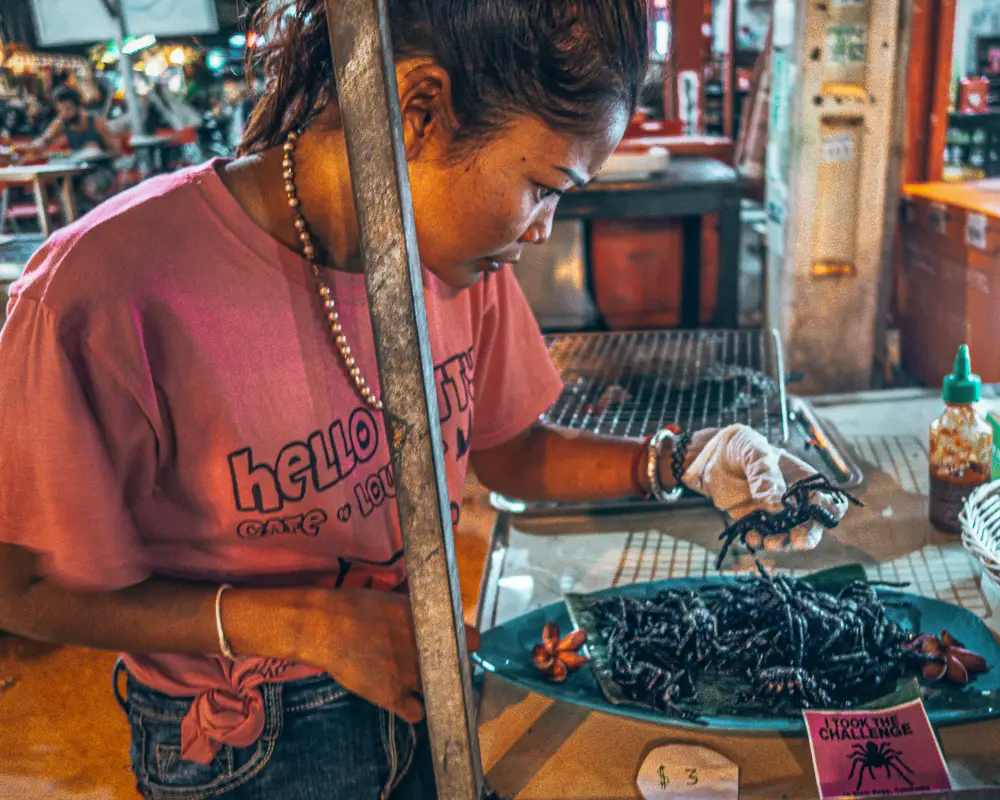
Will you take the challenge?
Fruit and Cambodian Desserts
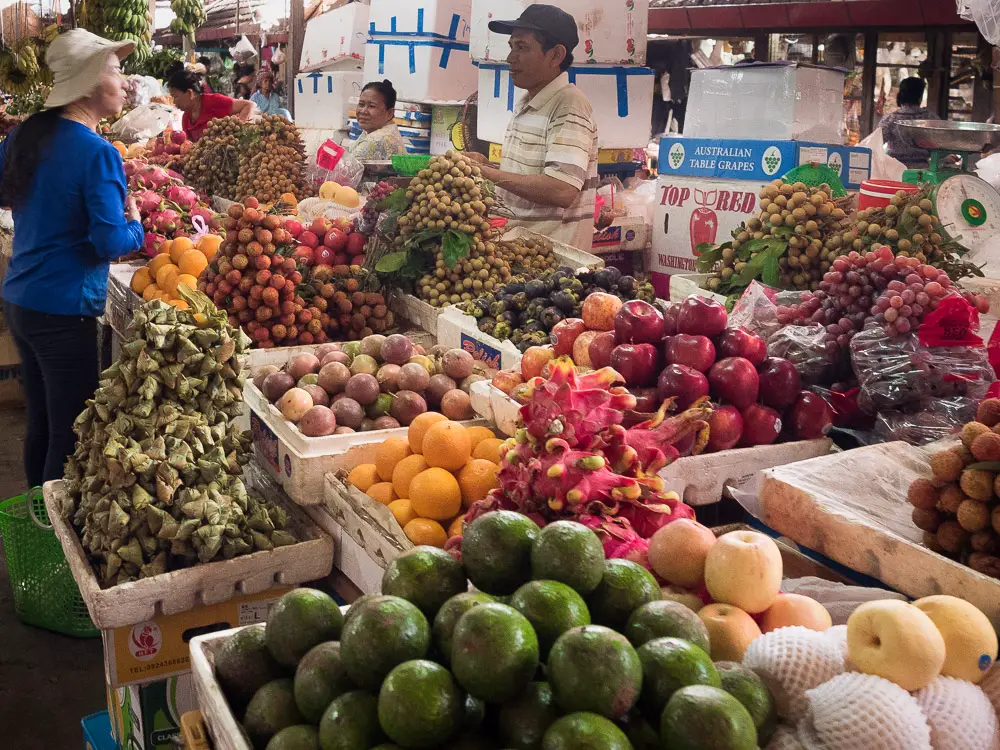
Just some of the range of fruit available in Cambodia.
Cambodia is blessed with a great range of tropical fruits, and we were lucky enough to visit the country during the mangosteen and durian season, although there are always many fruits available regardless of what is in season, including jackfruit, dragon fruit, bananas, mangoes, rambutan, apples, and oranges.
Desserts in Cambodia are luscious affair with Cambodians often mixing sweet and savoury ingredients, before adding even more sweet ingredients such as condensed milk and coconut cream.
Some of the more popular Cambodian desserts include mango and sticky rice, with coconut cream being added to the rice to enhance the sweetness of the dish, whilst Cha Houy Teuk is a sometimes riotous affair with colourful jellies mixed with sago and mung beans and covered in coconut cream and served in a bowl or cup with shaved ice.
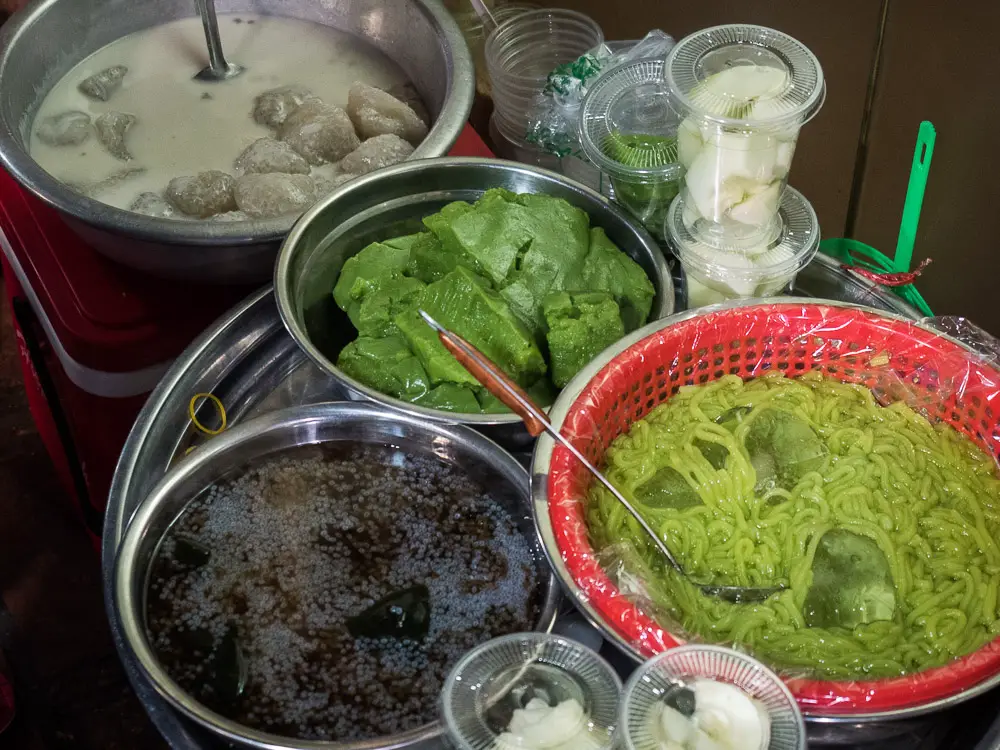
Some of the ingredients in a Cambodian dessert
Other popular desserts include Num Chak Kachan, a sweet glutinous treat made with rice flour, palm sugar, and coconut cream, and Num Ansom Chek, a handy package of steamed rice cake and banana that is served inside banana leaves.
Conclusion – What to Eat in Cambodia
The variety of Cambodia food, whether Khmer food or more classic Cambodian street food, will keep you satisfied when visiting Cambodia. Whilst the western food scene is well established, don’t leave Cambodia without trying at least some traditional Cambodian food or one of the many other varieties of food in Cambodia. In our more than 3 weeks in Cambodia, we have not been disappointed.

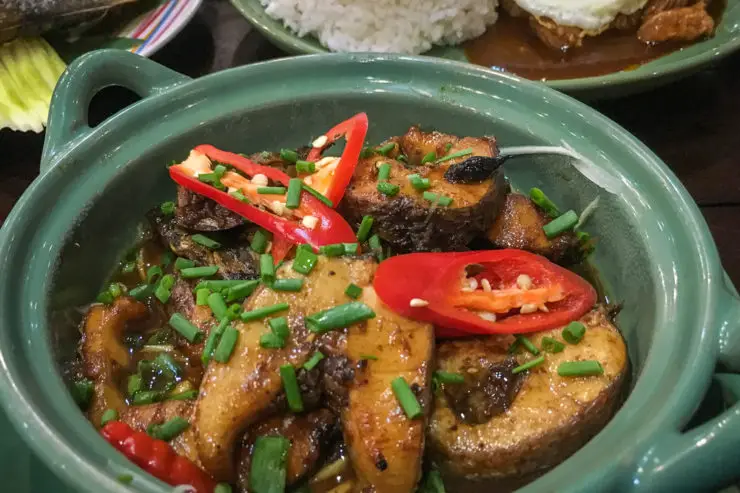
Great expose of the variety of Cambodian cuisine!
Cheers Stephen. Had fun trying the dishes.